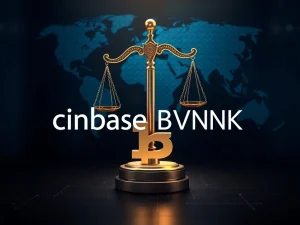Unmasking Lazarus Group: Crypto’s $6 Billion Supervillain Masterminds

In the thrilling, yet often turbulent world of cryptocurrency, tales of innovation and financial revolution are frequently shadowed by darker narratives of cybercrime. Among these, the Lazarus Group emerges as a figure of chilling notoriety, a shadowy entity that has become synonymous with large-scale cryptocurrency theft. But who are they, and how did a group allegedly linked to North Korea become the crypto industry’s most feared adversary? Let’s dive into the murky depths of Lazarus Group’s operations, tracing their evolution from traditional cyberattacks to their reign as crypto’s supervillains.
Who is Lazarus Group? Unveiling the Crypto Supervillain
Imagine a cybercriminal organization so sophisticated, so persistent, that it has amassed over $6 billion in illicit gains from the cryptocurrency sector alone since 2017. This is the staggering reality of the Lazarus Group. Often attributed to North Korea, this group is not your average band of hackers operating from a basement. They are believed to be a state-sponsored entity, meticulously organized and relentlessly focused on generating revenue for the regime through cybercrime.
While precise details about Lazarus Group remain shrouded in secrecy, cybersecurity experts and global intelligence agencies have pieced together a profile. Here’s what we know:
- State-Sponsored: Strong evidence suggests ties to North Korea, with objectives aligned with funding the nation’s programs.
- Highly Sophisticated: Lazarus Group employs advanced hacking techniques, constantly adapting to evolving cybersecurity measures.
- Financially Motivated: Unlike some hacktivist groups, their primary goal appears to be financial gain, specifically through cryptocurrency theft in recent years.
- Persistent and Patient: They are known for long-term campaigns, often spending months infiltrating systems before executing their heists.
- Global Reach: Their targets span across the globe, impacting exchanges, financial institutions, and even individual crypto users.
From Sony to Crypto Heists: The Evolution of Lazarus Group
Lazarus Group’s infamy didn’t begin with crypto hacks. Their origins trace back to more traditional cyber warfare and espionage. They first gained international attention for attacks on Sony Pictures Entertainment in 2014 and the WannaCry ransomware attack in 2017. These incidents showcased their capability to execute complex and damaging cyber operations.
However, as the cryptocurrency market exploded in popularity and value, Lazarus Group seemingly shifted its focus. The anonymity and decentralized nature of crypto presented a lucrative new frontier for their illicit activities. This pivot marked a significant evolution in their tactics, turning them into a major threat specifically within the digital asset space.
Consider this timeline:
| Year | Notable Activity |
|---|---|
| 2014 | Sony Pictures Entertainment hack |
| 2016 | Bangladesh Bank heist (SWIFT system attack) |
| 2017 | WannaCry ransomware attack; Shift towards cryptocurrency theft begins |
| 2017-Present | Numerous high-profile crypto hacks targeting exchanges and blockchain projects, accumulating billions in stolen assets. |
Decoding Lazarus Group’s Crypto Hacking Playbook
How does Lazarus Group consistently breach the seemingly impenetrable defenses of the crypto world? Their success lies in a combination of sophisticated techniques and a deep understanding of the vulnerabilities within the cryptocurrency ecosystem. While their exact methods are constantly evolving, some common tactics have been identified:
- Phishing and Social Engineering: Exploiting human error remains a key entry point. Deceptive emails and social media campaigns trick individuals into revealing credentials or downloading malware.
- Supply Chain Attacks: Compromising software or hardware supply chains to inject malicious code into widely used systems, granting access to numerous targets simultaneously.
- Zero-Day Exploits: Leveraging previously unknown software vulnerabilities (zero-days) to bypass security measures before patches are available.
- Advanced Persistent Threats (APTs): Maintaining long-term, stealthy access to target networks, allowing for reconnaissance, data exfiltration, and eventual fund theft.
- Mixers and Tumblers: Utilizing services that obfuscate transaction trails to launder stolen cryptocurrency and make it harder to trace back to their origins.
Bybit and Beyond: Lazarus Group’s Expanding Target List
While the provided content mentions Bybit, it’s crucial to understand that Lazarus Group’s reach extends far beyond a single exchange. They have targeted a wide array of entities within the crypto sphere, including:
- Cryptocurrency Exchanges: Major centralized and decentralized exchanges are prime targets due to the large volumes of assets they hold.
- Blockchain Bridges: These cross-chain communication protocols have proven to be vulnerable points, allowing for massive fund drains.
- Decentralized Finance (DeFi) Platforms: Smart contract vulnerabilities and protocol weaknesses in DeFi offer new avenues for exploitation.
- NFT Platforms: As the NFT market grows, it too has become a target, although often for lower value thefts compared to exchange hacks.
- Crypto Venture Capital Firms: Targeting firms that invest in crypto projects can provide access to sensitive information and potentially future attack vectors.
The sheer diversity of targets underscores the pervasive threat Lazarus Group poses to the entire cryptocurrency industry. No sector within crypto seems immune to their sophisticated attacks.
The Shocking Impact of Lazarus Group on the Crypto Industry
The billions stolen by Lazarus Group represent more than just financial losses. Their activities have far-reaching consequences for the crypto industry and its users:
- Erosion of Trust: High-profile hacks undermine confidence in the security of cryptocurrency exchanges and platforms, potentially hindering wider adoption.
- Market Instability: Large-scale thefts can trigger market downturns and volatility, impacting the value of cryptocurrencies and investor sentiment.
- Increased Security Costs: Crypto companies are forced to invest heavily in enhanced cybersecurity measures, diverting resources from innovation and growth.
- Regulatory Scrutiny: The rise in cybercrime, particularly attributed to groups like Lazarus, intensifies regulatory pressure on the crypto industry, potentially leading to stricter regulations.
- Victim Impact: Ultimately, individuals and businesses lose their hard-earned assets, causing financial hardship and emotional distress.
Can Crypto’s Supervillain Be Stopped? Challenges and Countermeasures
Combating Lazarus Group is a complex and ongoing battle. Their state sponsorship, advanced capabilities, and evolving tactics make them a formidable adversary. However, efforts are underway on multiple fronts:
- International Law Enforcement Collaboration: Agencies worldwide are working together to track and disrupt Lazarus Group’s operations, although extradition and prosecution can be challenging.
- Enhanced Cybersecurity Measures: Crypto exchanges and platforms are constantly upgrading their security protocols, adopting advanced threat detection and prevention systems.
- Blockchain Analytics and Tracing: Companies specializing in blockchain analysis are developing tools to trace stolen funds and identify laundering patterns, making it harder for Lazarus Group to profit from their crimes.
- User Education and Awareness: Educating crypto users about phishing scams, social engineering tactics, and best security practices is crucial in preventing attacks at the individual level.
- Sanctions and Financial Pressure: Governments are imposing sanctions on individuals and entities associated with Lazarus Group and North Korea to cut off funding sources and limit their operational capacity.
Conclusion: The Unending Saga of Crypto Crime
Lazarus Group’s journey from hacking Sony to becoming crypto‘s supervillain is a stark reminder of the ever-present threat of cybercrime in the digital age. Their relentless pursuit of cryptocurrency theft highlights the need for constant vigilance, robust security measures, and international cooperation within the crypto industry and beyond. While stopping them completely may be an ongoing challenge, a multi-pronged approach combining technology, law enforcement, and user awareness offers the best hope of mitigating their impact and safeguarding the future of the cryptocurrency ecosystem. The saga of Lazarus Group and crypto hacks is far from over, and the industry must remain prepared for the next chapter in this unfolding drama.







